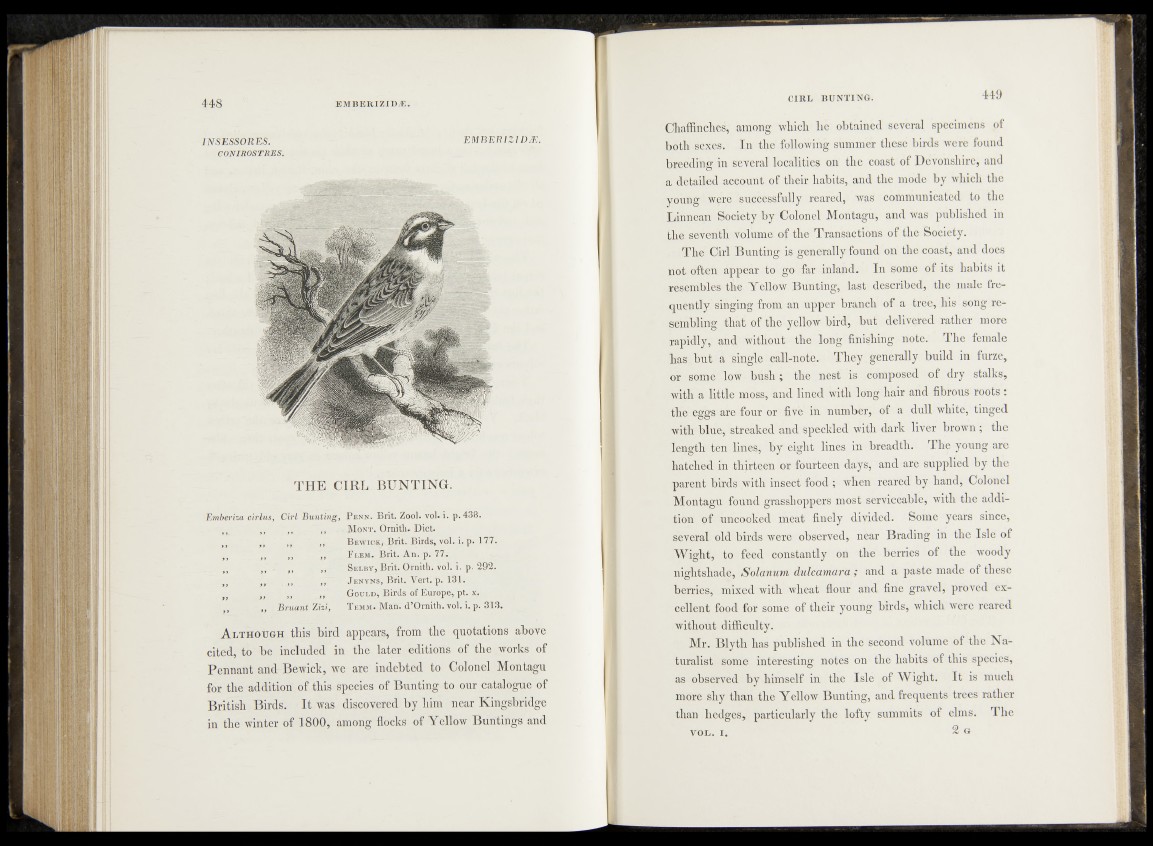
INSESSORES. EMBER IZIDJE.
CONIROSTRES.
TH E CIRL BUNTING.
Emberiza cirlus, Cirl Buntin
„ Bruant Zizi,
P enn. Brit. Zool. vol. i. p.438.
M ont. Ornitli. Diet.
B ewick, Brit. Birds, vol. i. p. 177.
F lem. Brit. An. p. 77.
Selby, Brit. Ornith. vol. i. p. 292.
J enyns, Brit. Vert. p. 131.
Gould, Birds of Europe, pt. x.
T emm. Man. d’Ornith. vol. i. p. 313.
A lthough this bird appears, from the quotations above
cited, to be included in the later editions of the works of
Pennant and Bewick, we are indebted to Colonel Montagu
for the addition of this species of Bunting to our catalogue of
British Birds. It was discovered by him near Kingsbridge
in the winter of 1800, among flocks of Yellow Buntings and
Chaffinches, among which he obtained several specimens of
both sexes. In the following summer these birds were found
breeding in several localities on the coast of Devonshire, and
a detailed account of their habits, and the mode by which the
young were successfully reared, was communicated to the
Linnean Society by Colonel Montagu, and was published in
the seventh volume of the Transactions of the Society.
The Cirl Bunting is generally found on the coast, and does
not often appear to go far inland. In some of its habits it
resembles the Yellow Bunting, last described, the male frequently
singing from an upper branch of a tree, his song resembling
that of the yellow bird, but delivered rather more
rapidly, and without the long finishing note. The female
has but a single call-note. They generally build in furze,
or some low bush; the nest is composed of dry stalks,
with a little moss, and lined with long hair and fibrous roots :
the eggs are four or five in number, of a dull white, tinged
with blue, streaked and speckled with dark liver brown ; the
length ten lines, by eight lines in breadth. The young are
hatched in thirteen or fourteen days, and are supplied by the
parent birds with insect food ; when reared by hand, Colonel
Montagu found grasshoppers most serviceable, with the addition
of uncooked meat finely divided. Some years since,
several old birds were observed, near Brading in the Isle of
Wight, to feed constantly on the berries of the woody
nightshade, Solarium, dulcamara ; and a paste made of these
berries, mixed with wheat flour and fine gravel, proved excellent
food for some of their young birds, which were reared
without difficulty.
Mr. Blyth has published in the second volume of the Naturalist
some interesting notes on the habits of this species,
as observed by himself in the Isle of Wight. I t is much
more shy than the Yellow Bunting, and frequents trees rather
than hedges, particularly the lofty summits of elms. The
v o l . i . ® g